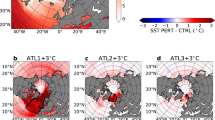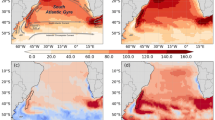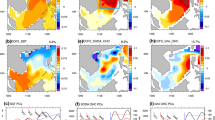Abstract
Sea ice is a quite sensitive indicator in response to regional and global climate changes. Based on monthly mean Pan-Arctic Ice Ocean Modeling and Assimilation System (PIOMAS) sea ice thickness fields, we computed the conductive heat flux (CHF) in the Arctic Ocean in the four winter months (November–February) for a long period of 36 years (1979–2014). The calculated results for each month manifest the increasing extension of the domain with high CHF values since 1979 till 2014. In 2014, regions of roughly 90% of the central Arctic Ocean have been dominated by the CHF values larger than 18 W m−2 (November–December) and 12 W m−2 (January–February), especially significant in the shelf seas around the Arctic Ocean. Moreover, the population distribution frequency (PDF) patterns of the CHF with time show gradually peak shifting toward increased CHF values. The spatiotemporal patterns in terms of the trends in sea ice thickness and other three geophysical parameters, surface air temperature (SAT), sea ice thickness (SIT), and CHF, are well coupled. This suggests that the thinner sea ice cover preconditions for the more oceanic heat loss into atmosphere (as suggested by increased CHF values), which probably contributes to warmer atmosphere which in turn in the long run will cause thinner ice cover. This represents a positive feedback mechanism of which the overall effects would amplify the Arctic climate changes.
Similar content being viewed by others
References
Alexeev, V. A., Ivanov, V. V., Kwok, R., and Smedsrud, L. H., 2013. North Atlantic warming and declining volume of arctic sea ice. Cryosphere Discussions, 7 (1): 245–265.
Döscher, R., Vihma, T., and Maksimovich, E., 2015. Recent advances in understanding the Arctic climate system state and change from a sea ice perspective: A review. Atmospheric Chemistry & Physics, 14 (7): 10929–10999.
Fichefet, T., and Maqueda, M., 1997. Sensitivity of a global sea ice model to the treatment of ice thermodynamics and dynamics. Journal of Geophysical Research: Oceans (1978–2012), 102 (C6): 12609–12646.
Giles, K. A., Laxon, S. W., and Ridout, A. L., 2008. Circumpolar thinning of Arctic sea ice following the 2007 record ice extent minimum. Geophysical Research Letters, 35 (22): L22502.
Holland, M. M., and Bitz, C. M., 2003. Polar amplification of climate change in coupled models. Climate Dynamics, 21 (3–4): 221–232.
Holland, M. M., Bitz, C. M., Hunke, E. C., Lipscomb, W. H., and Schramm, J. L., 2006. Influence of the sea ice thickness distribution on polar climate in CCSM3. Journal of Climate, 19 (11): 2398–2414.
Krishfield, R. A., and Perovich, D. K., 2005. Spatial and temporal variability of oceanic heat flux to the Arctic ice pack. Journal of Geophysical Research Oceans, 110 (7): 691–706.
Kurtz, N. T., Farrell, S. L., Studinger, M., and Galin, N., 2012. Sea ice thickness, freeboard, and snow depth products from Operation IceBridge airborne data. Cryosphere Discussions, 6 (6): 4771–4827.
Kurtz, N. T., Galin, N., and Studinger, M., 2014. An improved CryoSat-2 sea ice freeboard and thickness retrieval algorithm through the use of waveform fitting. Cryosphere, 8 (1): 721–768.
Kurtz, N. T., Markus, T., Cavalieri, D. J., Sparling, L. C., Krabill, W. B., Gasiewski, A. J., and Sonntag, J. G., 2009. Estimation of sea ice thickness distributions through the combination of snow depth and satellite laser altimetry data. Journal of Geophysical Research Oceans, 114 (C10): 637–644.
Kwok, R., Cunningham, G., Wensnahan, M., Rigor, I., Zwally, H., and Yi, D., 2009. Thinning and volume loss of the Arctic Ocean sea ice cover: 2003–2008. Journal of Geophysical Research: Oceans (1978–2012), 114: C07005.
Kwok, R., and Rothrock, D. A., 2009. Decline in Arctic sea ice thickness from submarine and ICESat records: 1958–2008. Geophysical Research Letters, 36 (15): L15501.
Kwok, R., and Untersteiner, N., 2011. The thinning of Arctic sea ice. Physics Today, 64 (4): 36–41.
Laxon, S. W., Giles, K. A., Ridout, A. L., Wingham, D. J., Rosemary, W., Robert, C., Ron, K., Axel, S., Zhang, J., and Christian, H., 2013. CryoSat-2 estimates of Arctic sea ice thickness and volume. Geophysical Research Letters, 40 (4): 732–737.
Lei, R., Li, N., Heil, P., Cheng, B., Zhang, Z., and Sun, B., 2014. Multiyear sea-ice thermal regimes and oceanic heat flux derived from an ice mass balance buoy in the Arctic Ocean. Journal Geophysical Research: Oceans, 119: 537–547.
Lei, R., Xie, H., Wang, J., Leppäranta, M., Jónsdóttir, I., and Zhang, Z., 2015. Changes in sea ice conditions along the Arctic Northeast Passage from 1979 to 2012. Cold Regions Science and Technology, 119: 132–144.
Lindsay, R. W., 1998. Temporal variability of the energy balance of thick Arctic Pack Ice. Journal of Climate, 11 (3): 313–333.
Lindsay, R. W., Zhang, J., Schweiger, A., Steele, M., and Stern, H., 2009. Arctic sea ice retreat in 2007 follows thinning trend. Journal of Climate, 22 (1): 165–176.
Lique, C., 2015. Ocean science: Arctic sea ice heated from below. Nature Geoscience, 8: 172–173.
Martin, S., Drucker, R., Kwok, R., and Holt, B., 2004. Estimation of the thin ice thickness and heat flux for the Chukchi Sea Alaskan coast polynya from special sensor microwave/imager data, 1990–2001. Journal of Geophysical Research: Oceans (1978–2012), 109: C10012.
Maslanik, J., Fowler, C., Stroeve, J., Drobot, S., Zwally, J., Yi, D., and Emery, W., 2007. A younger, thinner Arctic ice cover: Increased potential for rapid, extensive sea-ice loss. Geophysical Research Letters, 34: L24501.
Maslanik, J., Stroeve, J., Fowler, C., and Emery, W., 2011. Distribution and trends in Arctic sea ice age through spring 2011. Geophysical Research Letter, 38 (13): 392–392.
Maykut, G. A., 1978. Energy exchange over young sea ice in the central Arctic. Journal of Geophysical Research: Oceans (1978–2012), 83 (C7): 3646–3658.
Maykut, G. A., 1982. Large-scale heat exchange and ice production in the central Arctic. Journal of Geophysical Research Atmospheres, 87 (NC10): 7971–7984.
Park, D. S. R., Lee, S., and Feldstein, S. B., 2015. Attribution of the recent winter sea ice decline over the Atlantic sector of the Arctic Ocean. Journal of Climate, 28: 4027–4033.
Parkinson, C. L., and Washington, W. M., 1979. A large-scale numerical model of sea ice. Journal of Geophysical Research, 84 (C1): 311–337.
Peng, G., Meier, W. N., Scott, D. J., and Savoie, M. H., 2013. A long-term and reproducible passive microwave sea ice concentration data record for climate studies and monitoring. Earth System Science Data, 6 (1): 311–318.
Perovich, D. K., and Bruce, E., 2002. Estimates of ocean heat flux at SHEBA. Geophysical Research Letters, 29 (9): 58.
Perovich, D. K., Grenfell, T. C., Richter-Menge, J. A., Light, B., Tucker, W. B., and Eicken, H., 2003. Thin and thinner: Ice mass balance measurements during SHEBA. Journal of Geophysical Research, 108 (C3), Doi: 10.1029/2001JC00107.
Perovich, D. K., Iii, W. B. T., and Krishfield, R. A., 1989. Oceanic heat flux in the Fram Strait measured by a drifting buoy. Geophysical Research Letters, 16 (9): 995–998.
Pie, N., Urban, T. J., and Schutz, B. E., 2013. Cross-Validating ICESat-1 and CryoSat-2 using Tide Gauge Measurements. AGU Fall Meeting. San Francisco, USA, 1–4.
Polyakov, I. V., Timokhov, L. A., Alexeev, V. A., Bacon, S., Dmitrenko, I. A., Fortier, L., Frolov, I. E., Gascard, J. C., Hansen, E., and Ivanov, V. V,. 2010. Arctic Ocean warming contributes to reduced polar ice cap. Journal of Physical Oceanography, 40 (12): 2743–2756.
Rothrock, D., Percival, D., and Wensnahan, M., 2008. The decline in arctic sea-ice thickness: Separating the spatial, annual, and interannual variability in a quarter century of submarine data. Journal of Geophysical Research: Oceans (1978–2012), 113: C05003.
Rothrock, D. A., Yu, Y., and Maykut, G. A., 1999. Thinning of the Arctic sea-ice cover. Geophysical Research Letters, 26 (23): 3469–3472.
Schweiger, A., Lindsay, R., Zhang, J., Steele, M., Stern, H., and Kwok, R., 2011. Uncertainty in modeled Arctic sea ice volume. Journal of Geophysical Research: Oceans (1978–2012), 116: C00D06.
Serreze, M. C., Barrett, A. P., Slater, A. G., Michael, S., Zhang, J., and Trenberth, K. E., 2007a. The large-scale energy budget of the Arctic. Journal of Geophysical Research Atmospheres, 112 (D11): 71–81.
Serreze, M. C., Holland, M. M., and Stroeve, J., 2007b. Perspectives on the Arctic’s shrinking sea-ice cover. Science, 315 (5818): 1533–1536.
Song, C., Ye, Q., Sheng, Y., and Gong, T., 2015. Combined ICESat and CryoSat-2 altimetry for accessing water level dynamics of Tibetan lakes over 2003–2014. Water, 7: 4685–4700.
Steele, M., Ermold, W., and Zhang, J., 2008. Arctic Ocean surface warming trends over the past 100 years. Geophysical Research Letters, 35 (2): L02614.
Steele, M., Zhang, J., and Ermold, W., 2010. Mechanisms of summertime upper Arctic Ocean warming and the effect on sea ice melt. Journal of Geophysical Research: Oceans (1978–2012), 115: C11004.
Stroeve, J., Barrett, A., Serreze, M., and Schweiger, A., 2014. Using records from submarine, aircraft and satellites to evaluate climate model simulations of Arctic sea ice thickness. Cryosphere, 8 (5): 1839–1854.
Tonboe, R. T., Pedersen, L. T., and Haas, C., 2009. Simulation of the satellite radar altimeter sea ice thickness retrieval uncertainty. Canadian Journal of Remote Sensing, 36 (2): 513–559.
Untersteiner, N., 1964. Calculations of temperature regime and heat budget of sea ice in the central Arctic. Journal of Geophysical Research Atmospheres, 69 (22): 4755–4766.
Wettlaufer, J. S., 1991. Heat flux at the ice-ocean interface. Journal of Geophysical Research Atmospheres, 96 (C4): 7215–7236.
Zhang, J., and Rothrock, D. A., 2003. Modeling global sea ice with a thickness and enthalpy distribution model in generalized curvilinear coordinates. Monthly Weather Review, 131 (5): 845–861.
Zhang, J., Lindsay, R., Steele, M., and Schweiger, A., 2008. What drove the dramatic retreat of arctic sea ice during summer 2007? Geophysical Research Letters, 35: L11505.
Zwally, J., Yi, D., Ron, K., and Zhao, Y., 2008. ICESat measurements of sea ice freeboard and estimates of sea ice thickness in the Weddell Sea. Journal of Geophysical Research Atmospheres, 113: C02S15.
Zygmuntowska, M., Rampal, P., Ivanova, N., and Smedsrud, L., 2013. Uncertainties in Arctic sea ice thickness and volume: New estimates and implications for trends. The Cryosphere Discussions, 7: 5051–5095.
Acknowledgements
We would like to thank the data providers. PIOMAS sea ice thickness data are provided by the Polar Science Center (PSC) in Applied Physics Laboratory (APL) at University of Washington. Snow depth, wind speed, and surface air temperature data are obtained from NCEP/NCAR products.
Author information
Authors and Affiliations
Corresponding author
Rights and permissions
About this article
Cite this article
Fan, X., Bi, H., Wang, Y. et al. Increasing winter conductive heat transfer in the Arctic sea-ice-covered areas: 1979–2014. J. Ocean Univ. China 16, 1061–1071 (2017). https://doi.org/10.1007/s11802-017-3359-8
Received:
Revised:
Accepted:
Published:
Issue Date:
DOI: https://doi.org/10.1007/s11802-017-3359-8




